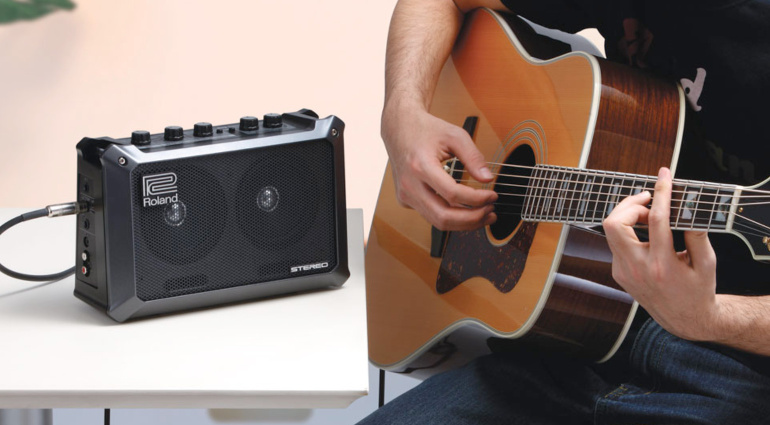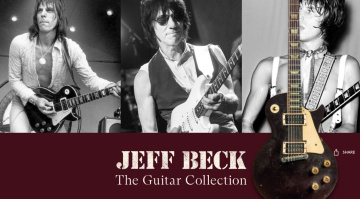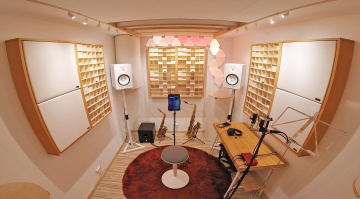The 7 Best Acoustic Guitar Amps for Every Budget: For Buskers, Backyards & Big Stages
You can't just use your electric guitar amp!
Whether you’re busking on a street corner, jamming at home, or playing an intimate gig, an acoustic guitar amp can truly take your tone to the next level. These amps are built to capture every nuance of your playing, from delicate fingerpicking to full-strummed chords. In this guide, we’ll break down the best options for every budget.
Our Picks:
Acoustic Guitar Amps: Amplify your Wonderwall
An acoustic guitar amp is designed for one job: faithful sound reproduction. It shouldn’t make your guitar sound like anything else. These amps typically have a flat frequency-response voicing, which means that they don’t color your guitar’s sound too much.
Electric guitar amps are often about shaping and transforming tone through adding gain, distortion, and character, while an acoustic amp mostly avoids that. In addition, electric amps typically expect magnetic pickups as the type of guitar signal they sound best with. In contrast, acoustic guitar amps usually include features such as tweeters, XLR inputs (for a microphone or a direct DI signal), and anti-feedback filters to handle live acoustic rigs.
Because of these differences, you might run into a variety of tonal issues when you plug your acoustic into any electric guitar amp, like unwanted distortion. Moreover, the speaker might overcolor the sound, and the amp may struggle to reproduce the full acoustic spectrum. On the flip side, an an electric guitar plugged into an acoustic amp will usually work, but you’ll be playing against a very ‘transparent’ system not designed for gain-heavy sonics.
What to Look for
The first consideration about acoustic guitar amps is where you’ll actually play them. Street corners? Coffee shops? Home studios? Portability, power, and tone shape matter most. A good acoustic guitar amp should be loud enough to fill a small venue but light enough to carry without breaking your back. And battery power is a big plus if you plan to perform outdoors or move between sets.
Next, look for features that fit your playing style. If you plan to sing and play simultaneously, amps with two input channels (one for your guitar and one with an XLR jack for your microphone) come in handy. Regarding built-in effects like reverb, delay, or chorus, it’s all a matter of style and taste. Although it might make sense to use dedicated pedals for that.
Features like feedback control, EQ shaping, and direct outputs also help keep things balanced, whether you’re performing, recording, or rehearsing. Overall, the best acoustic guitar amps for your budget are the ones that take your playing and busking to the next level. As always, we’ve simply ranked these by price, no other metric.
Harley Benton HBAC-20
The Harley Benton HBAC-20 offers 20 watts of power as an 8-inch speaker and tweeter combo. It offers two channels: one for mic/CD/line and one for your instrument, so you can plug in vocals or backing tracks alongside your guitar.
This acoustic guitar amp also features a 3-band EQ with parametric mids, built-in chorus and reverb, an active/passive switch, and a line-out for PA or recording. If you’re after an acoustic guitar amp that offers full features at a modest price, check this one out at Thomann*. And if you mainly practice on headphones at home and play the occasional open-mic stage, there is also HB’s Custom Line Acoustic Preamp*.
Roland Mobile Cube
A little Roland Micro Cube was the very first amp I ever owned when I started playing the guitar. Waaaay back in the day. While these don’t hold a candle to your Marshalls or Fenders, I’ve kept a soft spot for them because of them. But also, I’m not a busker. But if you are one, there is really nothing like the Cube series.
This smallest version of the current iteration of the series can last up to 15 hours with six AA batteries, so it’s perfect for busking. It also offers inputs for guitar, microphone (Note: line input, so you might need an adapter!), and an aux in for backing tracks. If you need more power, inputs, or other features, Roland offers a host of different cube amps. Check this entry in our list of the best acoustic guitar amps out at Thomann*.
Fishman Loudbox Micro
If you’re coming from the world of electric guitars, you might have encountered Fishman as the makers of the mighty Fluence pickups. But these guys don’t just make incredible-sounding electronics; they also build great acoustic guitar amps.
For some reason, the world of acoustic guitar amps has agreed on a wooden look to distinguish itself from the often black electric guitar amps. Fishman’s Loudbox series looks the part. The Loudbox Micro*, for example, offers dual inputs, separate effects for acoustic guitar and vocals, a headphone jack for practicing at home, and an aux in for backing tracks.
Boss Acoustic Singer Live LT
Stepping things up, the Boss Acoustic Singer Live LT offers 60 watts of clean bi-amped power and a custom two-way speaker system, so it’ll sound great for both acoustic guitar and vocals. Two independent channels let you balance your voice and instrument perfectly, each with its own EQ and effects (reverb, delay, or chorus).
The proprietary Acoustic Resonance feature restores some of the warmth lost in piezo pickups, while anti-feedback tools keep your sound from creating that feared high-pitched noise. This tilt-back cabinet also projects your tone naturally, and the XLR DI and USB outputs make recording or PA connection a breeze. In addition to the smaller, more compact LT version*, there is also the mighty ACS Live* that includes a phantom-powered mic input and a harmonizer. And if you just need a preamp with loads of effects to connect to a PA, there is always the Boss VE8 Acoustic Singer*.
Fender Acoustic Junior GO
Well, look at that, Fender is part of the gang, too! Besides their famed Deluxe Reverb series, the strat maker also offers a line of acoustic guitar amps. The Acoustic Junior Go outputs a mighty 100 watts, features two combo inputs (both either line or XLR), and a load of useful features. It sounds amazing, too.
The Acoustic Junior Go also includes a 90-second looper, Bluetooth connectivity, a headphone jack and an aux in, and two line outputs to connect it to a PA. With one charge, this model will run up to 12 hours at moderate volume and up to five hours at a high volume. Perfect for stages and busking. It’s available at Thomann*.
Hughes & Kettner Era 1 Wood
Stepping into pro territory, the ERA 1 Wood brings a whopping 250 watts of clean headroom to the table. That’s more than enough even for bigger venues without a PA. With a custom 8″ driver and 1″ dome tweeter, the ERA 1 delivers full-range sound that preserves the nuances of your guitar and voice. Its dual high-resolution mic/instrument channels (with optional phantom power) let you run vocals and guitar side by side,
In total, the ERA 1 offers four channels. Channels 1 and 2 offer two-mode EQ voicings (steel vs. nylon-string), 16 internal FX programmes, and a dedicated notch filter in the master section to counter feedback on stage. Channel 3 takes AUX in, channel 4 is an FX return. It’s basically a micro-PA in a single unit. Check it out at Thomann*.
AER Compact 60 IV
Crowning our list of the best acoustic guitar amps, the AER Compact 60 IV BK offers 60 watts of power feeding a custom 8″ twin-cone speaker. Its dual-channel layout supports both guitar and mic/line sources, complete with independent tone controls and high/low switches for flexibility.
In terms of features, the Compact 60 IV offers onboard reverb, delay, and chorus, a DI output, switchable pre/post effects, an FX send/return, and a headphone out all wrapped in a 7.1 kg chassis. There is a whole range of dedicated acoustic guitar amps from AER to choose from, check them out at Thomann*.
*Disclaimer: This post about the best acoustic guitar amps contains affiliate links and/or widgets. When you buy a product via our affiliate partner, we receive a small commission that helps support what we do. Don’t worry, you pay the same price. Thanks for your support!


 3,7 / 5,0 |
3,7 / 5,0 | 







